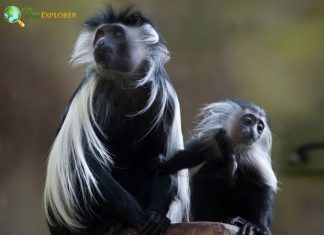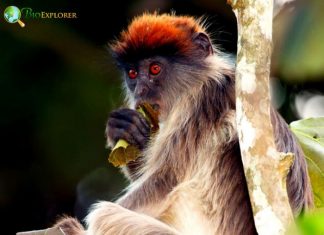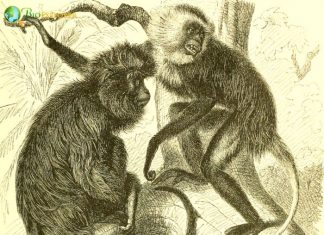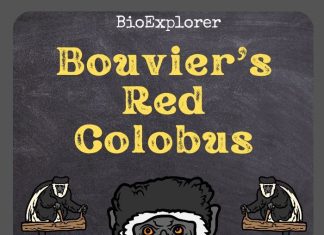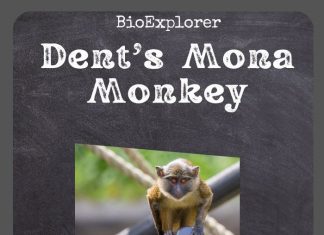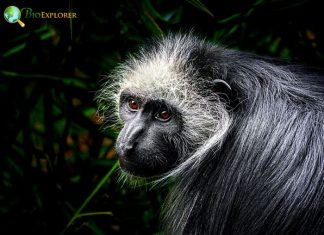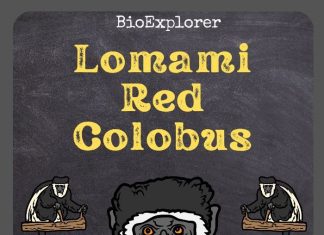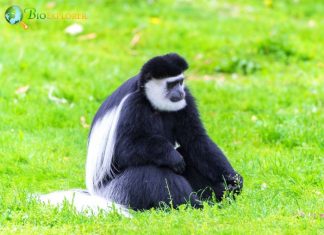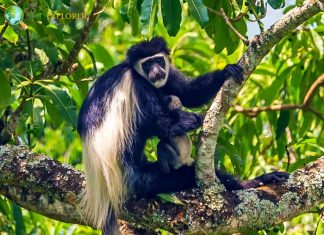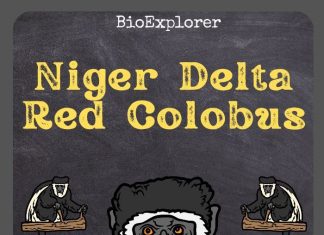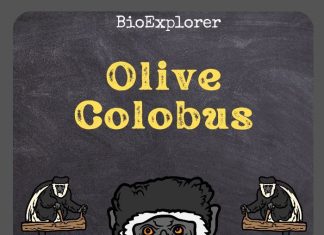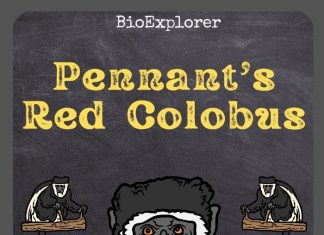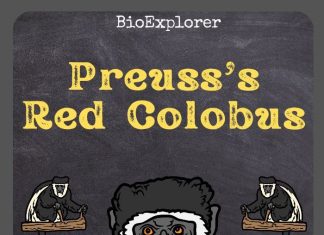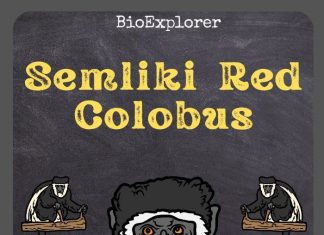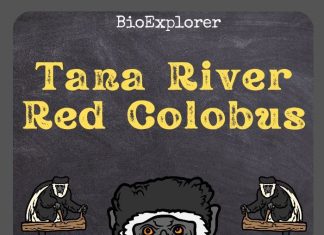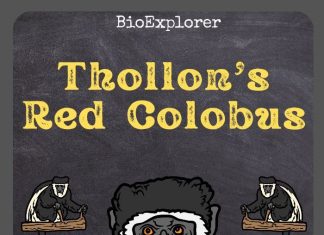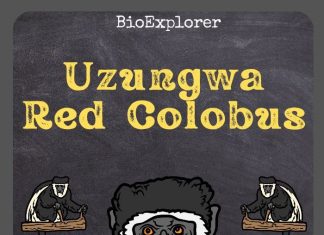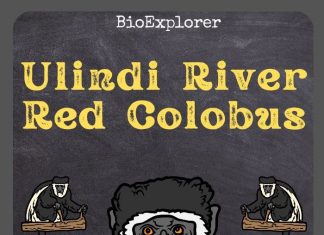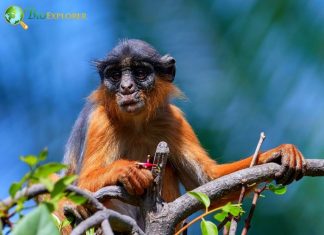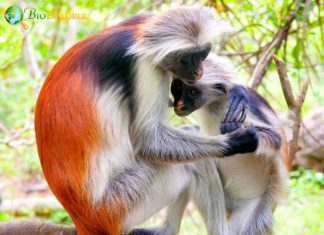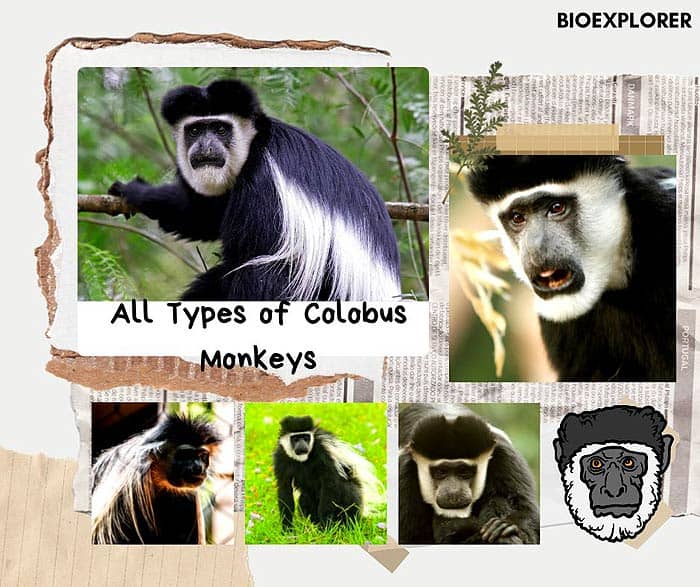
Colobus monkeys are Old world monkeys of the genus Colobus endemic to Africa. Several of the Colobus monkey species are Red Colobus monkeys.
Colobus monkeys forage on flowers, leaves, and fruits. Consequently, these African primates play a vital role in seed dispersal.
The male king colobus is the largest colobus monkey, with an average weight of about 9.90 kg. On the other hand, the Procolobus verus is the smallest colobus monkey with an average body weight of 4.5 kg.
Types of Colobus Monkeys
Angolan Colobus
Species Name: Colobus angolensis
The Angolan Colobus is a conspicuously-patterned monkey with a very long tail that helps it maintain its balance as it moves quickly through the trees. Although the species is named after Angola, it's rare in this country.
Ashy Red Colobus
Species Name: Piliocolobus tephrosceles
The Ashy-red Colobus or Ugandan red Colobus is an endangered species of red Colobus endemic to Eastern Africa. Like other colobus monkeys, Ashy Red has small thumbs that allow it to comfortably grip branches and swing nimbly through the canopy. In 2001, the ashy-red Colobus was recognized as a separate species.
Black colobus
The black colobus, also known as satanic black colobus, is a species of Old-World monkey in the Colobus genus. The black colobus is the oldest of the 5 recognized species in the genus Colobus and is said to have diverged 3 to 4 million years ago.
Bouvier’s Red Colobus
Species Name: Piliocolobus bouvieri
Bouvier's Red Colobus was rediscovered in 2015 in the Republic of Congo after four decades without confirmed sightings. These African primates live in the swampy forests surrounding the Congo River, between the mouths of the Oubangui and Alima rivers.
Dent’s Mona Monkey
Species Name: Cercopithecus denti
The expressive face of Dent's mona monkey is characterized by golden eyes; a flat, long, dark nose; and a pink chin and mouth. Dent mona monkeys are often found in the company of other primate species.
Foa’s Red Colobus
Species Name: Piliocolobus foai
Foa's Red Colobus or Central African red colobus is endemic to the Democratic Republic of the Congo. Generally, these African primates are found in large groups of 20 to 90 individuals.
King Colobus
Species Name: Colobus polykomos
The king colobus (Colobus polykomos), also called the western black and white colobus is a species of Old World monkey found in lowland and montane rainforests.
Lang’s Red Colobus
Species Name: Piliocolobus langi
Lang's red colobus (Piliocolobus langi) is another species of red colobus monkey. Historically, it was treated as a subspecies of the Central African red colobus (Piliocolobus foai). Still, more recent taxonomies generally treat it as a distinct species.
Lomami Red Colobus
Species Name: Piliocolobus parmentieri
The Lomami red colobus (Piliocolobus parmentieri) is native to central Africa. The Lomani red colobus monkey has a restricted range in the lowland rainforest between the Lomani River and the Lualaba River in the central Democratic Republic of the Congo.
Mantled Guereza
Species Name: Colobus guereza
The mantled guereza (Colobus guereza), also known as the guereza, Abyssinian black-and-white colobus, or eastern black-and-white colobus, is a black-and-white colobus, a species of Old World monkey. The mantled guerezas are typically diurnal.
Miss Waldron’s Red Colobus
Species Name: Piliocolobus waldronae
Miss Waldron's red colobus (Piliocolobus waldronae) is endemic to West Africa. Miss Waldron's red colobus was discovered in December 1933 by Willoughby P. Lowe, a collector at the British Museum (Natural History).
Mount Kilimanjaro Guereza
Species Name: Colobus caudatus
The Mount Kilimanjaro guereza (Colobus caudatus) is one of the 7 subspecies of the mantled guereza. It is found in Kenya and Tanzania in the forests surrounding Mount Meru and Mount Kilimanjaro.
Niger Delta Red Colobus
Species Name: Piliocolobus epieni
The Niger Delta red colobus (Piliocolobus epieni) is a critically endangered colobus native to the western part of the Niger Delta in southern Nigeria. The scientific name of the Niger Delta red colobus, Piliocolobus epieni, comes from the local Ijaw language word for the species, "epieni".
Olive Colobus
Species Name: Procolobus verus
The olive colobus (Procolobus verus), also called the Van Beneden's colobus or green colobus is a primate species in the Cercopithecidae family. It is the smallest specimen of all the Colobine monkeys. It is rarely seen in its natural habitat due to its secretive nature and cryptic coloration.
Oustalet’s Red Colobus
Species Name: Piliocolobus oustaleti
(Piliocolobus oustaleti) is another species of red colobus that lives in various forest types in the southern Central African Republic, southern South Sudan, northern Democratic Republic of the Congo, and northeastern Congo.
Pennant’s Red Colobus
Species Name: Piliocolobus pennantii
Pennant's Colobus or Pennant's Red Colobus (Piliocolobus pennantii) is a species of arboreal primate in the Cercopithecidae family. Like other red colobus monkeys, the Pennant's red colobus lives in flocks that may consist of 12 to 80 individuals occupying a territory of 25 to 150 hectares.
Preuss’s Red Colobus
Species Name: Piliocolobus preussi
Preuss's red colobus (Piliocolobus preussi) is native to the Cross-Sanaga Rivers eco-region. These old-world monkeys are restricted to small areas in Cameroon and Nigeria but once occupied a much larger area.
Semliki Red Colobus
Species Name: Piliocolobus semlikiensis
The Semliki red colobus (Piliocolobus semlikiensis) is native to central Africa. The Semliki red colobus lives in the ironwood forest of the northeastern Democratic Republic of the Congo between the Rwenzori Mountains and the Semliki River valley.
Tana River Red Colobus
Species Name: Piliocolobus rufomitratus
The Tana River red colobus (Piliocolobus rufomitratus), also called the eastern red colobus, is a critically endangered primate species in the Cercopithecidae family. The Tana River red colobus monkeys are the only one of 18 species of red colobus that do not live in the tropical rainforest.
Thollon’s Red Colobus
Species Name: Piliocolobus tholloni
The Thollon's red colobus (Piliocolobus tholloni), also called the Tshuapa red colobus, is native to the Democratic Republic of the Congo and the Lower Republic of the Congo. It was recognized as a separate species by Dandelot in 1974, followed by Groves in 2001.
Udzungwa Red Colobus
Species Name: Piliocolobus gordonorum
The Udzungwa red colobus (Piliocolobus gordonorum), also called the Iringa red colobus or the Uzungwa red colobus is endemic to Tanzania.
Ulindi River Red Colobus
Species Name: Piliocolobus lulindicus
The Ulindi River red colobus (Piliocolobus lulindicus) is native to the Democratic Republic of the Congo. This Red Colobus species is named after the Ulindi River.
Ursine Colobus
Species Name: Colobus vellerosus
The white-thighed colobus (Colobus vellerosus), also known as ursine colobus, white-thighed black-and-white colobus, and Geoffroy's black-and-white colobus, is a species of primate in the Cercopithecidae family.
Western Red Colobus
Species Name: Piliocolobus badius
The western red colobus (Piliocolobus badius), also called the Upper Guinean red colobus, rust red colobus, or bay red colobus is a species of Old-World monkey found in the forests of West Africa, from Senegal to Ghana.
Zanzibar Red Colobus
Species Name: Piliocolobus kirkii
The Zanzibar red colobus (Piliocolobus kirkii) is endemic to Unguja, the main island of the Zanzibar archipelago off the coast of Tanzania. The Zanzibar red colobus, often referred to as Kirk's red colobus is named after Sir John Kirk, the British resident of Zanzibar who first spotted these creatures.


